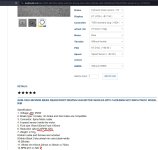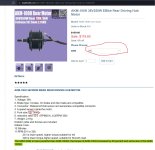TheBeastie
1 MW
I am in the market for a new ebike kit, I want to get a 27.5inch based mountain bike for urban use, not much in hills, probably the biggest hill I ever face is about 400meters of roughly 13degree angle (I would guess), or just your quite average suburban road hills, and it would be just once per ride, AFAIK what cooks motors is too much hill for too long causing the heat to build up..
I aim for decent efficiency, good take off and speed. I like to minimize the frequency of recharging my battery, so I have been thinking 350W motor is about right for my needs. All my ebike batteries are either S12 18650 based or higher voltage.
And I think I just want to get a KT 6 mosfet sine wave controller, I have always only had 500W 9mosfet versions in the past but I always find myself only riding about 350watt most of the time, and would prefer the smaller discreet size of the 6S controller.
Most motors (especially the 350W) are listed as "36V" but some listed are 48V. I've been wondering if this actually an important spec or is even a made up one? As isn't the total watts more important? or is there actual components inside a 36V motor that are more likely to fail if 48V is given even if your just putting 6amps into the motor and the total watts of power inputted is the same?
I have been looking at this site for the AKM 100H 350w motors and notice some kits like this one below are listed as 328RPM 48V 350W motor only, and there is no selectable RPM option for this motor, it just lists 328RPM as highlighted in red color, I was under the assumption that larger sized wheels aren't compatible for 328RPM, but I can select a 27.5" or 700c sized wheel for it, is that assumption wrong?

Also, for the listing above of the single non-changeable 48V 328RPM motor option, it also makes it a bit more confusing by listing: "12. RPM201 or 328". Does that mean that you actually just get what ever specified RPM motor they feel like giving you on that day that could be 201 or 328?
This 350W motor page listing that is 36V based is FAR more clear, it provides 201 or 328RPM choice options in the drop-down menu order box, so you can't go wrong in making an order and getting what you listed. But why is this for 36V only and not 48V?
And then on top, for this 36V 350W motor only listing (no rim build), it offers three different RPM choices, 201 or 260 or 328RPM are selectable options in the drop-down menu order box. Why is there another RPM option for this particular motor of 260 and again this is 36V only, no 48V option. And why is the fork size also different listed as "Fork size: 137.5mm" when the other (supposedly same motor for the other pages) is "Fork size: Rear 135mm"? And also to make it a bit extra weird they have 36/32hole listed in the image, so is there a 32hole version?
I was thinking if I had a choice then the 260RPM 48V 350W 100H would be the best overall choice for a 27.7" wheel and my riding location. And then on top I would want a 32hole motor and reuse the rim that came with my bike if I lace the motor myself. They do have a 32hole 350W front-motor but not rear motor option. AKM-100H 36V350W EBike Rear Driving Hub Motor [AKM-100H rear motor] - $119.60 : Zen Cart!, The Art of E-commerce
Something that has annoyed me for a long time and has now become an "Oh, I see, ok then fine" moment, is the mystery behind the different versions of geared motors for CST and freewheel models. I always thought it was dumb to not offer CST on everything since all modern bikes only come with cassettes and that it's a waste to throw them away..
But NOW I understand that the old threaded-freewheel design allows the internal motor to be wider and thus give more torque and there is no way around that other than to use a freewheel with perhaps less gears. That is fine, I will happily throw away my cassette that came with my bike for basically any double digit percent of higher torque, it just needed to be explained somewhere.
Another thing is, ALL Chinese based sellers seem to have their motor listings like as generally described above where you really wonder what you're getting in rpm/voltage/size and even spoke holes.
Anyone have any thoughts/suggestions?
Thanks all.
I aim for decent efficiency, good take off and speed. I like to minimize the frequency of recharging my battery, so I have been thinking 350W motor is about right for my needs. All my ebike batteries are either S12 18650 based or higher voltage.
And I think I just want to get a KT 6 mosfet sine wave controller, I have always only had 500W 9mosfet versions in the past but I always find myself only riding about 350watt most of the time, and would prefer the smaller discreet size of the 6S controller.
Most motors (especially the 350W) are listed as "36V" but some listed are 48V. I've been wondering if this actually an important spec or is even a made up one? As isn't the total watts more important? or is there actual components inside a 36V motor that are more likely to fail if 48V is given even if your just putting 6amps into the motor and the total watts of power inputted is the same?
I have been looking at this site for the AKM 100H 350w motors and notice some kits like this one below are listed as 328RPM 48V 350W motor only, and there is no selectable RPM option for this motor, it just lists 328RPM as highlighted in red color, I was under the assumption that larger sized wheels aren't compatible for 328RPM, but I can select a 27.5" or 700c sized wheel for it, is that assumption wrong?
AKM-100H 48V350W Ebike Rear/Front Driving Hub Motor 36holes with 16/20/26inch/27.5inch/700CC wheel rim [AKM-48V350W Rear motor 26/700cc] - $104.50 : Zen Cart!, The Art of E-commerce
Zen Cart! AKM-100H 48V350W Ebike Rear/Front Driving Hub Motor 36holes with 16/20/26inch/27.5inch/700CC wheel rim [AKM-48V350W Rear motor 26/700cc] - ★★★★★ AKM-100H 48V350W Ebike Rear/Front Driving Hub Motor 36holes with 16/20/26inch/27.5inch/700CC wheel rim Specification: 1. Voltage: 48V 350W...
www.topbikekit.com

Also, for the listing above of the single non-changeable 48V 328RPM motor option, it also makes it a bit more confusing by listing: "12. RPM201 or 328". Does that mean that you actually just get what ever specified RPM motor they feel like giving you on that day that could be 201 or 328?
This 350W motor page listing that is 36V based is FAR more clear, it provides 201 or 328RPM choice options in the drop-down menu order box, so you can't go wrong in making an order and getting what you listed. But why is this for 36V only and not 48V?
AKM-100H 36V350W EBike Front /Rear Driving Hub Motor+16/20/26inch/27.5inch/28inch wheel rim [AKM-36V350W Front motor 26/700cc] - $99.75 : Zen Cart!, The Art of E-commerce
Zen Cart! AKM-100H 36V350W EBike Front /Rear Driving Hub Motor+16/20/26inch/27.5inch/28inch wheel rim [AKM-36V350W Front motor 26/700cc] - ★★★★★ AKM-100H 36V350W EBike Front/Rear Driving Hub Motor 36holes with 20/26inch/700CC wheel rim Specification: 1. Voltage: 36V 350W 2. Brake type...
www.topbikekit.com
And then on top, for this 36V 350W motor only listing (no rim build), it offers three different RPM choices, 201 or 260 or 328RPM are selectable options in the drop-down menu order box. Why is there another RPM option for this particular motor of 260 and again this is 36V only, no 48V option. And why is the fork size also different listed as "Fork size: 137.5mm" when the other (supposedly same motor for the other pages) is "Fork size: Rear 135mm"? And also to make it a bit extra weird they have 36/32hole listed in the image, so is there a 32hole version?
AKM-100H 36V350W EBike Rear Driving Hub Motor [AKM-100H rear motor] - $123.50 : Zen Cart!, The Art of E-commerce
Zen Cart! AKM-100H 36V350W EBike Rear Driving Hub Motor [AKM-100H rear motor] - ★★★★★ AKM-100H 36V350W EBike Rear Driving Hub Motor Specification: 1. Voltage: 36V. 2. Brake type: V-brake, rim brake and disc brake are compatible 3. Connector: Waterproof Hall sensor and sensorless compatible...
www.topbikekit.com
I was thinking if I had a choice then the 260RPM 48V 350W 100H would be the best overall choice for a 27.7" wheel and my riding location. And then on top I would want a 32hole motor and reuse the rim that came with my bike if I lace the motor myself. They do have a 32hole 350W front-motor but not rear motor option. AKM-100H 36V350W EBike Rear Driving Hub Motor [AKM-100H rear motor] - $119.60 : Zen Cart!, The Art of E-commerce
Something that has annoyed me for a long time and has now become an "Oh, I see, ok then fine" moment, is the mystery behind the different versions of geared motors for CST and freewheel models. I always thought it was dumb to not offer CST on everything since all modern bikes only come with cassettes and that it's a waste to throw them away..
But NOW I understand that the old threaded-freewheel design allows the internal motor to be wider and thus give more torque and there is no way around that other than to use a freewheel with perhaps less gears. That is fine, I will happily throw away my cassette that came with my bike for basically any double digit percent of higher torque, it just needed to be explained somewhere.
Another thing is, ALL Chinese based sellers seem to have their motor listings like as generally described above where you really wonder what you're getting in rpm/voltage/size and even spoke holes.
Anyone have any thoughts/suggestions?
Thanks all.
Attachments
Last edited:


